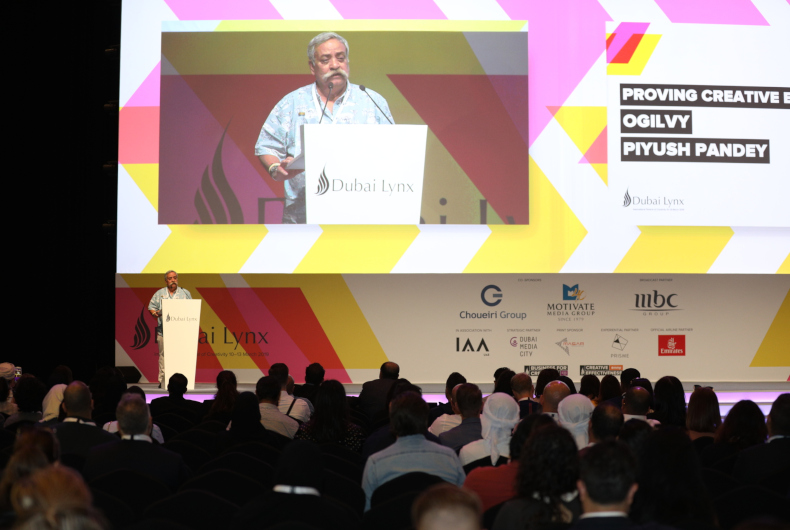 How do you measure tears? And hugs? Such were the questions raised on the hot topic of measuring creative effectiveness by Ogilvy veteran and India’s iconic adman Piyush Pandey at the 2019 edition of Dubai Lynx. Apart from pondering about hard yet real questions like these, I came away with a lot of food for thought from the Dubai Lynx International Festival of Creativity held this week.
How do you measure tears? And hugs? Such were the questions raised on the hot topic of measuring creative effectiveness by Ogilvy veteran and India’s iconic adman Piyush Pandey at the 2019 edition of Dubai Lynx. Apart from pondering about hard yet real questions like these, I came away with a lot of food for thought from the Dubai Lynx International Festival of Creativity held this week.
1. “No one can tell me how to make money… I don’t want to restrict my talent, so I always remove exclusivity clauses from my contracts” said Steve Harvey, American comedian and TV host. For someone who catapulted from homelessness to global fame, it is little wonder that Harvey knows the value of money. Still very much wearing his heart on his sleeve, the media personality made it loud and clear that the only way to success was through grit and grind. His appeal to millennials was to adopt an old-school work ethic but maintain their new-age thinking.
2. We can strive for perfection, but perfection is overrated. Michael Boychuck, Former Executive Creative Director of Amazon highlighted that some of the best works can emerge from failure. It is possible to win with what’s wrong. Failure needs to be worn like a badge. His campaigns for Alexa, including the Super Bowl ad ‘Not everything makes the cut’ and the Amazon Echo SNL parody prove that smart consumers will respond favorably to humanized brands that embrace their flaws.
3. Designing a seamless customer journey across all touchpoints is not just the responsibility of the marketing department but that of the entire organization. But in creating positive customer experiences, Hussein M. Dajani (General Manager – Digital and Customer Experience Transformation, Nissan) acutely pointed out that it is important to define the customer as both internal and external. Companies must not lose focus of their employees who equally need to be engaged and champion their offerings on and offline.
4. Purpose is the new punk, stated Rob Reilly, Global Creative Chairman, McCann Worldgroup. Creativity is how the world solves problems; creativity can heal and save lives. And purpose elevates creativity. Not gold, not oil, not data, but creativity is the world’s greatest asset. Reilly demonstrated this with the goosebumps-inducing video montage of McCann New York’s award-winning ‘March for our Lives Price Tag’ campaign which disrupted the classic gun-control conversation.
5. If there’s a market, there’s also a market share. Many companies in the Middle East are adopting a Saudi-first approach. And Moustafa Ismail, CEO – Smaat Co gave us the four key gateways to penetrating KSA with brand messaging. Content should be in Arabic; it should have cultural relevance; it can be amplified through local macro and micro influencers; and finally, not leveraging the mushrooming youth and entertainment platforms would be opportunities missed.
6. Saudi Arabia was further demystified. As brands, how do we communicate within the kingdom where more than 75 percent of the population is under 30 years? The world’s most avid YouTube users are in Saudi Arabia. How then do we use social media platforms which are akin to the modern day Saudi majlis? We need to abandon stereotypes, and Hessa Alsudairy (Creative Director, J. Walter Thompson KSA) unboxed some recent cultural shifts for us. As the community fabric is moving from ‘tribal’ to ‘nuclear’, there is also an immense shift from him to her. What Alsudairy said next has stayed with me — long gone are the times when girls had their lives charted out for them by someone else; in the new era Saudi, women are in fact thankful to be born female. And Nissan’s #SheDrives campaign was cited as a precedent of a brand that has made the inroads so smartly – an impactful message delivered in the right way at the right time.
7. Gender diversity has clearly transitioned from conversation to action and I have three pieces of evidence for you. First, I observed many more female speakers at Dubai Lynx compared to the previous year. Second, along with the ‘See It Be It’ initiative, we saw the introduction of the Glass Lynx as an award category. And third, the constant mention of the ‘Fearless Girl’ campaign by speaker after speaker, was indication that organizations not yet fast-tracking the diversity agenda will be left behind.
8. And now for the million-dollar question — how do you train your brain to become more creative? Bas Korsten of J. Walter Thompson Amsterdam spilled the beans using insights from his research ‘The Brain Project’. Apart from eating more apples, doing cardio, soaking in some nature, breathing right and other findings, what was interesting was that if you want to be at your creative best, involve people with opposing views or a stranger in your conversations. Simply having the presence of this person will put you on your toes and can unlock your creative genius.
9. Thomas Muller generously elaborated on the seven Fjord Trends 2019. The one that resonated most with me was ‘Silence is gold’. Consumers are getting bogged down with too much messaging and advancements in technology are making this noise deafening. Brands need to tone down and adopt simpler approaches if they are to benefit from consumer responsiveness. The next time you think about opting for the big and bold approach, maybe there is merit in giving it a second thought.
10. Coming back full circle with Piyush Pandey’s talk about measuring creative effectiveness. With the data versus creativity topic popping up in almost every session at the Lynx, Pandey professed that while numbers are a good measure of creative effectiveness, they can also be deceptive and should not be the only measure. What about the hugs, smiles, tears and pub conversations that your work generates? How do we measure that? While some genius kid is busy figuring that out in the confines of his dorm, the advertising guru is calling on the creative community to not just do good work but also work that does good for the community and earns goodwill.
In a nutshell, the times today are challenging for many — marketers and advertisers included. Brands have no way out but to persevere through grit and ingenuity using the limited tools at disposal. The need of the hour is to work very hard, and produce work that creates an impact, pushes the needle, influences culture, resonates with people, and ultimately improves lives even if a little.
To do this, we need to always be on reboot mode unlearning formulas & rules, for ideas can manifest anywhere and anytime. We just need the discipline, mindfulness and training to be ready for them, and bring them to life.




